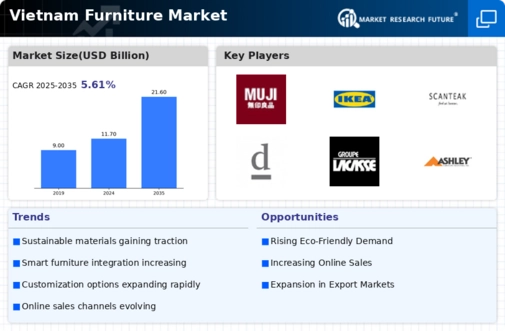E-commerce Growth
The rapid growth of e-commerce is a pivotal driver for the Vietnam Furniture Market, as more consumers turn to online platforms for their furniture needs. With internet penetration exceeding 70%, online shopping has become increasingly popular, offering convenience and a wider selection of products. This shift is prompting traditional retailers to enhance their online presence and invest in digital marketing strategies. Furthermore, the rise of social media platforms is facilitating direct engagement between brands and consumers, allowing for targeted advertising and personalized shopping experiences. As e-commerce continues to expand, it is likely to reshape the competitive landscape of the Vietnam Furniture Market, compelling businesses to adapt to changing consumer behaviors.
Rising Middle Class
The Vietnam Furniture Market is experiencing a notable surge in demand, primarily driven by the rising middle class. As disposable incomes increase, more consumers are willing to invest in quality furniture for their homes. This demographic shift is significant, with the middle class projected to reach 33 million by 2025, according to government statistics. The growing preference for modern and stylish furniture reflects changing lifestyles and aspirations. Consequently, manufacturers are adapting their offerings to cater to this evolving consumer base, focusing on both aesthetics and functionality. This trend not only boosts sales but also encourages innovation within the Vietnam Furniture Market, as companies strive to meet the diverse needs of a more affluent population.
Urbanization Trends
Urbanization is a critical driver of the Vietnam Furniture Market, as more individuals migrate to urban areas in search of better opportunities. The urban population is expected to reach 50% by 2025, leading to increased demand for residential and commercial furniture. This demographic shift necessitates the development of compact and multifunctional furniture solutions that cater to smaller living spaces typical of urban environments. Additionally, urban dwellers often seek contemporary designs that reflect their modern lifestyles. As a result, furniture manufacturers are likely to focus on innovative designs and materials that align with urban living trends, thereby enhancing their market presence in the Vietnam Furniture Market.
Sustainability Awareness
Sustainability awareness is increasingly influencing consumer choices within the Vietnam Furniture Market. As environmental concerns grow, consumers are more inclined to purchase eco-friendly furniture made from sustainable materials. This shift is prompting manufacturers to adopt greener practices, such as sourcing renewable resources and minimizing waste during production. According to recent surveys, over 60% of consumers express a preference for sustainable products, indicating a significant market opportunity for companies that prioritize environmental responsibility. This trend not only aligns with The Vietnam Furniture Industry.
Technological Advancements
Technological advancements are reshaping the Vietnam Furniture Market, particularly in manufacturing processes and consumer engagement. The integration of automation and smart technologies in production is enhancing efficiency and reducing costs. Moreover, the rise of augmented reality (AR) and virtual reality (VR) is transforming how consumers interact with furniture products. These technologies allow potential buyers to visualize how furniture will fit into their spaces before making a purchase. As a result, companies that leverage these innovations are likely to gain a competitive edge in the market. The ongoing digital transformation is expected to further streamline operations and improve customer experiences within the Vietnam Furniture Market.


















Leave a Comment